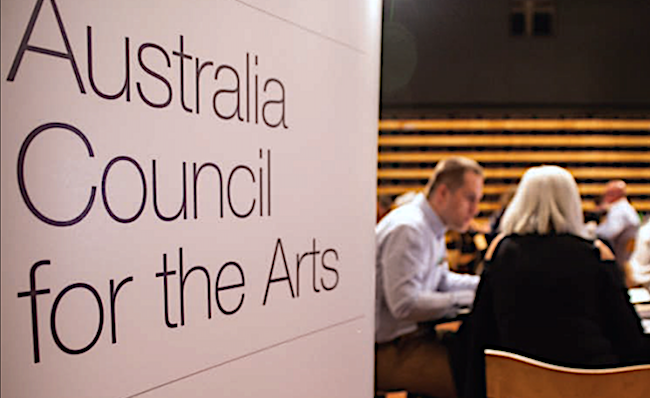Image shutterstock.com
What are the biggest issues in the arts today? How best to address them? And how bold would we like the Australia Council to be? These are the big questions before us in considering how best to contribute to the discussion paper for the Australia Council’s next strategic plan.
The sector stagnation since the seismic disruptions of the ‘Brandis Raid’ is, sadly, still with us. Artists’ incomes are falling, it’s taking longer for artists to become established, wages are flatlining or falling, too many public and commercial galleries are struggling or closing, and the gender pay gap is a scandal.
Unsurprisingly, the greatest disadvantage to emerge from this situation is experienced by artists with disability, artists of colour and regional artists.
Arts Access Australia has identified a 42% disability pay gap, which has worsened almost five-fold across the past decade. Diversity Arts Australia released an action plan as part of its Beyond Tick Boxes work that highlights the need to act now. Regional Arts Australia is calling for an extra $2m per year for the Regional Arts Fund, which is roughly half what it was less than a decade ago.
How does all of this affect artists and the arts sector? At best, it means a tightly controlled approach to risk; at worst, a stifling siege mentality and an unhelpful approach to the collaborations that are needed to see us through.
A toxic tension
We’re all having more and more conversations about stress, poor health, unsafe spaces, lateral violence and burnout.
An attendee of Diversity Arts Australia’s recent Fair Play symposium described a ‘quite toxic’ ‘competitive tension‘. They continued: ‘I think we have failed if when we come together, we treat each other with disrespect; and, that certain people feel they “own” certain “spaces” and discourses.’
APRA AMCOS’s Nicholas Pickard shared his concerns about ‘the hostility within the sector, the pointing at other parts of the sector and complaining whether they get funding or don’t get funding’, at Monash University and NAVA’s Australian Cultural Policy: The Next Decade a few weeks ago.
He continued: ‘I think it’s really unhealthy. We really need to try and create a lot more camaraderie and collaboration across the sectors.’
Matthew Westwood recently characterised the need for a ‘strong and fearless voice’ in a piece on advocacy for The Australian. And it’s not uncommon to see organisational leaders seeking moral and wellbeing support on social media when applying for major grants. Too many of us are frustrated and exhausted, despite being as passionately committed as ever.
Too many of us are frustrated and exhausted, despite being as passionately committed as ever.
For all these reasons and more, it’s very welcome to see sector development identified as a key strategic principle in the Australia Council’s next plan – one to which applicants to the Four-Year Organisations program have had to respond.
Initiatives that promote sector development were the equal biggest casualty of Brandis – equal to individual artists. Lasting change takes time; it’s difficult to sustain an approach to collaborative sector development when the organisations set up to do that work are poorly resourced, while others do their best plus trying to keep their own organisations afloat, and so in such circumstances, public tension seems inevitable.
We need to be honest about the personal toll of the past few years, while being constructive about what’s needed in ways that strengthen us all.
Already Adrian Collette AM has been outspoken about cultural diversity during his first weeks as Australia Council CEO. Companies who ignore their obligations are ‘out of touch’ and must change, he recently told the ABC: ‘I don’t care how big or how small you are.’
And already, Australia Council Chair Sam Walsh AO has been outspoken about artists’ rights and incomes, telling the industry audience at this year’s Australia Council Awards that, ‘Our artists should be celebrated – and they should be remunerated accordingly.’

Image courtesy Music Australia
Raising the bar
To make sure the Australia Council is emboldened to act on these expectations with helpful frameworks and consequences for inaction, it’s vital we make our own expectations clear. We’ve got until 10 May to respond to the strategic plan discussion paper and there’s a survey here.
There’s a great deal for us to contribute, and lots of questions that ask us ‘how important’ each element of the next strategic plan is to us. That’s a tough ask; they’re all important, and we’re not asked to rank them or compare, but happily there’s a text field at the end of each section for us to offer more sophisticated contributions.
To frame the plan, the Australia Council’s characterisation of the current situation covers issues across diversity, social cohesion, wellbeing, public value, artists’ incomes, social and technological change, harassment and cultural safety, and all quite comprehensively – but without the urgent tone that you or I might adopt.
First Nations arts and culture is in ‘high demand’ with ‘an increasing body of evidence’ available about its ‘critical role’ – but that whitefella view needs to be prefaced by the urgent need to put First Nations first in all aspects of cultural policy so that the entire nation learns.
The ‘growing value of social cohesion’ is certainly ‘a global policy consideration’ – but that’s because an intolerance and a violence has overtaken the political discourse in deeply disturbing ways, and the need for local and global responses is urgent.
The ‘declining creative income and viability of artist careers’ is indeed in conflict with how much Australians value the arts, but it’s also the clear and troubling sign of economic as well as cultural failure in our sector.
There’s no time to be lost in redressing all this and more.
When Brandis stripped away those funds without consultation, warning or justification back in 2015, the Australia Council was at the cusp of implementing the most significant sector development plans of its history, with Six Year Funding for organisations at last offering the certainty that S2M organisations needed so that they could pursue both artistic and sector-collaborative aims.
The minister knew this, having launched the plan himself with pride just a few months before. Instead, the future flourishing of the independent sector was undermined right at its moment of strength. This was no coincidence; it was impossible for the minister not to have known that unplanned disruption would cause significant destabilisation, with already disadvantaged sectors struggling the most.
What next?
The Australia Council’s next strategic plan needs to be framed and advocated with a clear sense of urgency.
So what can we do to support that? Let’s embolden the Australia Council to raise the bar for us all.
For ‘Memorable arts experiences for everyone’, let’s connect ‘memorable’ with how we value and assess our own work. Arts Council England, for example, have introduced ‘relevance’, an explicitly social and political measure which they see as complementing and not replacing ‘excellence’.
For ‘Our arts reflect us’, let’s demand funding consequences for companies who wilfully remain ‘out of touch’. It can’t always be up to those in positions of least advantage and power to keep calling out the ways that privilege keeps protecting itself.
For ‘First Nations arts and cultures are cherished’, let’s put First Nations first: in this document, in the Australia Council’s strategy, and in our own work.
For ‘Arts and creativity are thriving’, let’s really get this right this time. Let’s make fair payment for artists and a commitment to industry best practice a condition of funding contracts. Let’s not keep burdening organisations to do more with less, deprioritising artists’ payments in favour of what they assume will help artists more than fair pay.
After all, the failure of state and federal ministers to agree on a responsible new MPA Framework points to growing expectations for fairness in funding. ‘I don’t care how big or small you are.’ Let’s do this.
And for ‘Arts and creativity are valued’, let’s stop looking for new data and new evidence before stepping forward confidently as advocates. We have so much data; what we need is advocacy that’s influential, connected and consistently compelling.
A lot has been said about what the Australia Council could or should have done after the ‘Brandis Raid’. Beyond complaint, what are our specific expectations? What’s the Australia Council’s role, and what’s ours?
In contributing to the Australia Council’s next strategic plan, let’s look after the national interest in the same ways we look after one another: with care, generosity and urgency.





